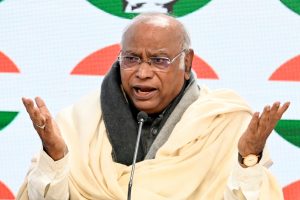‘Divine Victory’, a wooden sculpture by noted sculptor Neeraj Gupta, is being showcased as part of the ‘Ramayan Chitra Kavyam’ exhibition at the National Gallery of Modern Art in the national capital from March 1 to April 30.
There is an element of timelessness and ethereality in the figures of Ram and Sita as they look heavenwards, in the installation titled ‘Divine Victory’ by noted sculptor Neeraj Gupta.
Advertisement
The sculpture depicts the victorious homecoming of Ram with Sita, after vanquishing Ravan, artist Neeraj Gupta said.
Advertisement
What strikes you is the faceless quality of the figures – right from Ram and Sita, to the others sitting below – they could be Hanuman, Lakshman, or members of Ram’s army of monkeys who went with him to vanquish Ravan or even common folk.
Standing at nearly six feet and over five feet in width, and with a light terracotta finish, the wooden sculpture shows a standing Ram with his bow and a quiver full of arrows, with Sita draped in a flowing attire alongside him, while many figures are sitting below with their arms outstretched.
Neeraj hopes to pitch his current work for being included in a museum that is being set up in the newly consecrated Ram Mandir in Ayodhya.
“The figures are faceless, with no nose and eyes. It’s a blend of figuration and abstraction so that we can call it a work of contemporary art, which is different from craft. Had I made all those things, it would have become a work of craft,” Neeraj said.
Besides Ram and Sita, how does one identify Lakshman or Hanuman from the many other figures in the installation? There is nothing to identify them?
“That is left to the viewer. You can interpret it in different ways,” Neeraj said.
The sculpture basically depicts a scene of joyousness at Ram’s homecoming and each one is reacting in his or her way to that great episode, he added.
“Besides showcasing the triumph of Ram, it also symbolises the modern concept of spirituality – of how human beings can be detached from worldly things so that they enter the path of spirituality through those mythological teachings,” Neeraj said.
Advertisement











